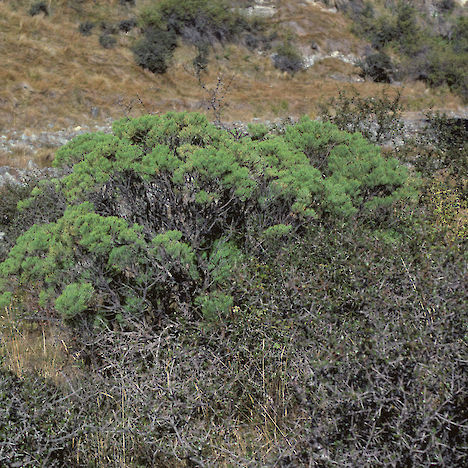Other names:
Hebe cupressoides, Leonohebe cupressoidesThreat category:
Threatened: Nationally Endangered?Regions:
Marlborough, Canterbury, OtagoDistribution:
Inland South Island
Key Features
- Previously known as Hebe cupressoides.
- A rounded, greyish-green, bushy shrub to 1.5 m tall, with densely-branching, slim, erect branches bearing scale leaves that are widely spaced along the branchlets.
- Scale leaves have a turpentine smell when crushed.
- Small, white or light purple flowers occur in clusters at the tips of branchlets.
- Seedlings have toothed leaves that are larger than the scale leaves of adults.
Distribution and Habitat
- South Island, east of the Main Divide from Lewis Pass to Otago.
- Veronica cupressoides occurs in montane shrublands in a variety of habitats including those that have been recently disturbed by flooding or slips as well as more stable habitats such as rock outcrops, bouldery moraines and terraces.
Threats
- Habitat modification and loss.
- Fire.
- Recruitment failure due to competition with weeds and grasses, and browse by stock, rabbits and hares.
Management Opportunities
- Survey for new locations.
- Mark known sites.
- Protection of habitat – avoid afforestation of known sites.
- Collect seed for propagation and re-establishment at appropriate sites.
- Ensure that forest owners are aware of potential habitats and can recognise the species.
Monitoring Options
- Check existing populations annually.
- Report new locations to DOC, NZPCN.
Further Information and Support
- New Zealand Plant Conservation Network (NZPCN). http://www.nzpcn.org.nz
- Pest control - Department of Conservation, Regional Councils.
- References:
- Dopson et al. (1999). The conservation requirements of New Zealand’s nationally threatened vascular plants. Threatened Species Occasional Publication 13. Department of Conservation, Wellington.
- Poole & Adams (1994). Trees and shrubs of New Zealand. Maanaki Whenua Press, Lincoln.
- Wilson & Galloway (1993). Small-leaved shrubs of New Zealand. Manuka Press, Christchurch.
- Wilson & Given (1989). Threatened plants of New Zealand. DSIR Publishing, Wellington.
- Peter de Lange, Peter Heenan, David Norton, Jeremy Rolfe and John Sawyer (2010). Threatened Plants of New Zealand. Canterbury University Press, Christchurch. 472 pp.



